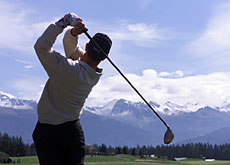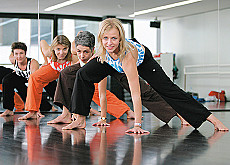Golf starts to lose elite status

As the golfing world turns its eyes towards the Swiss resort of Crans-Montana, more and more locals are taking up the sport, encouraged by lower costs.
The development of new courses by entrepreneurs and the involvement of retail giant Migros have helped golf in Switzerland to shed its image as an activity reserved for the wealthy.
The European Masters teed off in Crans on Thursday, bringing together the continent’s top players. But the glamour on show has little to do with golf as most people know it.
In two decades, the number of golf courses has nearly trebled in Switzerland, passing from 33 in 1987 to 94 by the end of this year. At the same time, membership of clubs has also risen substantially, passing from just under 14,000 to over 50,000.
“The development of golf in Switzerland generally mirrors what has been happening elsewhere,” said John Storjohann, general secretary of the Swiss Golf Association (SGA). “We are just a little bit behind the times.”
According to Storjohann, changes have been especially dramatic over the past ten years, encouraged by changes in land use and agricultural policies.
“It is simpler now to get the necessary authorisations to set up a golf course,” he told swissinfo. “Farmers are also prepared to part with land they no longer use.”
Retailer gets involved
Storjohann says that another major factor in the development of golf was the decision by Migros to open its own golf courses. A decision that surprised many observers given the sport’s elitist reputation in Switzerland, but was a logical move for the retailer.
“Migros took the same approach as it did with tennis, which wasn’t accessible to everybody either,” said Andrea Ming, Migros’ project leader for golf. “The company philosophy set out by founder Gottlieb Duttweiler was to make education and training available to everyone.”
So far Migros has seven golf courses, all except one in the German-speaking part of the country. Despite this small number of courses, the retailer reckons it has managed to make golf more democratic.
“It has become possible to play without being a member of an expensive club,” Ming told swissinfo.
“It has become like skiing where you pay for a daily pass. Our green fees are also lower than for comparable courses and that has helped attract new players.”
But it’s still expensive to play a round in Switzerland. Club membership can cost a few thousand Swiss francs, and green fees often hover around SFr100 ($83).
Migros’ Ming says that while golf is not exactly accessible to everyone, neither is skiing, a popular Swiss pastime.
Storjohann is more blunt about the cost factor.
“If you are not prepared to pay a SFr75 green fee, you might as well forget about it,” he said.
For the SGA’s general secretary, it would be difficult to cut prices anyway. “Today it’s entrepreneurs who build courses, and they want return on investment,” he added. “Even Migros considers it a business.”
The retailer admits that it isn’t subsidising its golfing business, as it does cultural activities. “It benefits our image, but we cannot make a loss,” points out Ming.
Attracting tourists
With golf being all about the bottom line, resorts have certainly been seeking to attract practitioners of the sport from abroad. Switzerland Tourism has been promoting golf holidays, but experts aren’t convinced that will be enough to attract foreigners.
“Switzerland doesn’t have the cachet of golf destinations such as England, Scotland, Ireland or the United States,” said Nicolas Délétroz of the Institute for Economy and Tourism in Sierre. “Our courses are certainly not as attractive, especially for the wealthy.”
Délétroz believes that selling individual golf destinations won’t work, but proposing a package might prove more attractive, both for foreigners and locals.
“People want to play where and when they want,” he told swissinfo. “If clubs want to attract more people at slow times, they should work together and propose circuits rather than try to go it alone.”
swissinfo, Scott Capper
Over 50,000 players are affiliated with a Swiss golf club.
There are 12,000 independent players.
By the end of 2007 there will be 94 courses in Switzerland, including 7 belonging to Migros.
In 2006 357,900 rounds were played on Migros courses.
In Switzerland, becoming a golfer is no easy task.
Before you start, clubs generally expect you to attend an initiation day. Then you have to take some theoretical and practical lessons.
After that there is a preparation course before you take an exam combining theory and practical aspects of golf that allows you to actually go on the course.
Once you have the authorisation, you then have to get a handicap, which either involves taking part in an official competition or playing three rounds to compile so-called Extra Day Scores.
Once you have fulfilled all these criteria, choose your course carefully: some won’t let you play if you are not with a member or if your handicap is not low enough.

In compliance with the JTI standards
More: SWI swissinfo.ch certified by the Journalism Trust Initiative

You can find an overview of ongoing debates with our journalists here. Please join us!
If you want to start a conversation about a topic raised in this article or want to report factual errors, email us at english@swissinfo.ch.